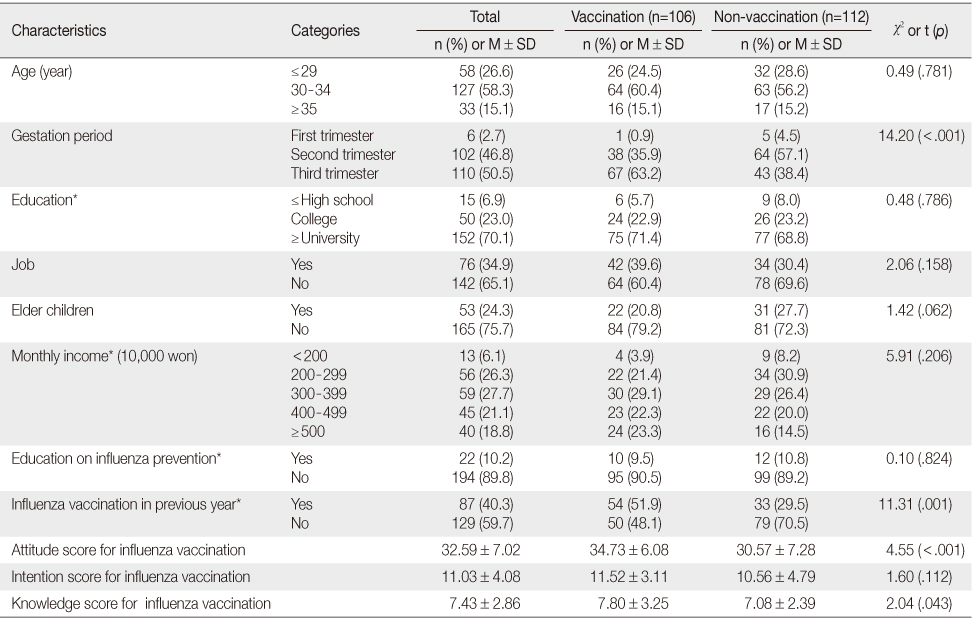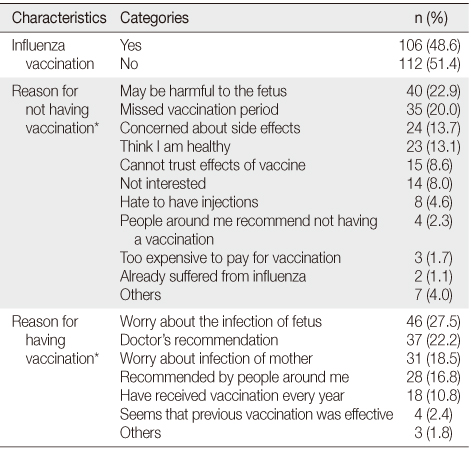Articles
- Page Path
- HOME > J Korean Acad Nurs > Volume 44(5); 2014 > Article
-
Original Article
- Current State of Influenza Vaccination and Factors Affecting Vaccination Rate among Pregnant Women
- Og Son Kim, Sung Won Yoon
-
Journal of Korean Academy of Nursing 2014;44(5):534-541.
DOI: https://doi.org/10.4040/jkan.2014.44.5.534
Published online: October 31, 2014
1Department of Nursing Science, Sangji University, Wonju, Korea.
2Department of Nursing, Chungwoon University, Hongseong, Korea.
- Address reprint requests to: Yoon, Sung Won. Department of Nursing, Chungwoon University, 25 University Street, Hongseong 350-701, Korea. Tel: +82-41-630-3275, Fax: +82-41-630-3275, icpsung@hanmail.net
© 2014 Korean Society of Nursing Science
This is an Open Access article distributed under the terms of the Creative Commons Attribution NoDerivs License. (http://creativecommons.org/licenses/by-nd/4.0/) If the original work is properly cited and retained without any modification or reproduction, it can be used and re-distributed in any format and medium.
Abstract
-
Purpose
- This study was done to examine the actual state of influenza vaccination among pregnant women and factors affecting vaccination rate.
-
Methods
- Data were collected using self-report questionnaires. Participants were pregnant women who participated in a prenatal education program at an acute care hospital in 2013. Data collected from 218 pregnant women were analyzed using the SPSS 18.0 Program.
-
Results
- Only 48.6% of the pregnant women had received vaccination when the influenza was prevalent. Statistically significant factors affecting the influenza vaccination rate among pregnant women were vaccination experience in the previous year, knowledge and attitude about vaccination, and gestation period.
-
Conclusion
- Results indicate that the influenza vaccination rate among pregnant women is lower than that of elders, healthcare workers, and patients with chronic diseases, who have been considered to be the mandatory vaccination recipients. Therefore, it is necessary to develop programs and policies which provide information including safety of vaccines for pregnant women and to induce positive attitudes towards vaccination for these women, in order to ultimately improve the vaccination rate.
- 1. Glezen WP. Serious morbidity and mortality associated with influenza epidemics. Epidemiol Rev. 1982;4:25–44.ArticlePubMed
- 2. Nicholson KG, Wood JM, Zambon M. Influenza. Lancet. 2003;362(9397):1733–1745. http://dx.doi.org/10.1016/s0140-6736(03)14854-4ArticlePubMedPMC
- 3. Brito V, Niederman MS. Pneumonia complicating pregnancy. Clin Chest Med. 2011;32(1):121–132. http://dx.doi.org/10.1016/j.ccm.2010.10.004ArticlePubMed
- 4. Rasmussen SA, Jamieson DJ, Bresee JS. Pandemic influenza and pregnant women. Emerg Infect Dis. 2008;14(1):95–100. http://dx.doi.org/10.3201/eid1401.070667ArticlePubMedPMC
- 5. Centers for Disease Control and Prevention. Preventing the flu: Good health habits can help stop germs [Internet]. Atlanta, GA, Author. 2010;cited 2013 January 11. Available from: http://www.cdc.gov/flu/protect/habits.htm
- 6. Noh JY, Kim WJ. Influenza vaccines: Unmet needs and recent developments. Infect Chemother. 2013;45(4):375–386. http://dx.doi.org/10.3947/ic.2013.45.4.375ArticlePubMedPMC
- 7. Hubka TA, Wisner KP. Vaccinations recommended during pregnancy and breastfeeding. J Am Osteopath Assoc. 2011;111:10 Suppl 6. S23–S30.PubMed
- 8. Kim MJ, Lee SY, Lee KS, Kim A, Son D, Chung MH, et al. Influenza vaccine coverage rate and related factors on pregnant women. Infect Chemother. 2009;41(6):349–354. http://dx.doi.org/10.3947/ic.2009.41.6.349Article
- 9. Im JH. Alteration in influenza vaccination of the pregnant women and related factors since the pandemic in 2009 [master's thesis]. Incheon, Inha University. 2014.
- 10. Kee SY, Lee JS, Cheong HJ, Chun BC, Song JY, Choi WS, et al. Influenza vaccine coverage rates and perceptions on vaccination in South Korea. J Infect. 2007;55(3):273–281. http://dx.doi.org/10.1016/j.jinf.2007.04.354ArticlePubMedPMC
- 11. Kim SK. Configuration of a vaccination-behavior model for mothers with infants [dissertation]. Seoul, Chung-Ang University. 2007.
- 12. Yu DS, Low LP, Lee IF, Lee DT, Ng WM. Predicting influenza vaccination intent among at-risk chinese older adults in Hong Kong. Nurs Res. 2014;63(4):270–277. http://dx.doi.org/10.1097/nnr.0000000000000028ArticlePubMed
- 13. Kim OS. Status of and factors influencing vaccination against the pandemic (H1N1) 2009 virus among university students from the fields of nursing and allied health. J Korean Acad Nurs. 2011;41(3):403–410. http://dx.doi.org/10.4040/jkan.2011.41.3.403ArticlePubMed
- 14. Maher L, Hope K, Torvaldsen S, Lawrence G, Dawson A, Wiley K, et al. Influenza vaccination during pregnancy: Coverage rates and influencing factors in two urban districts in Sydney. Vaccine. 2013;31(47):5557–5564. http://dx.doi.org/10.1016/j.vaccine.2013.08.081Article
- 15. Zhang J, While AE, Norman IJ. Nurses' vaccination against pandemic H1N1 influenza and their knowledge and other factors. Vaccine. 2012;30(32):4813–4819. http://dx.doi.org/10.1016/j.vaccine.2012.05.012ArticlePubMed
- 16. Ozer A, Arikan DC, Kirecci E, Ekerbicer HC. Status of pandemic influenza vaccination and factors affecting it in pregnant women in Kahramanmaras, an eastern Mediterranean city of Turkey. PLoS One. 2010;5(12):e14177. http://dx.doi.org/10.1371/journal.pone.0014177ArticlePubMedPMC
- 17. Park GS. The study on the health center avian influenza worker's knowledge, attitude and practical skills about management of avian influenza [master's thesis]. Busan, Inje University. 2006.
- 18. Lu PJ, Santibanez TA, Williams WW, Zhang J, Ding H, Bryan L, et al. Surveillance of influenza vaccination coverage-United States, 2007-08 through 2011-12 influenza seasons. MMWR Surveill Summ. 2013;62(4):1–28.
- 19. Park MB, Kim CB, Joo HS. Factors influencing on influenza vaccination coverage. J Korea Contents Assoc. 2013;13(4):300–311. http://dx.doi.org/10.5392/JKCA.2013.13.04.300Article
- 20. Centers for Disease Control and Prevention. Seasonal influenza vaccination coverage among women who delivered a live-born infant - 21 states and New York City, 2009-10 and 2010-11 influenza seasons. MMWR Morb Mortal Wkly Rep. 2013;62(49):1001–1004.PubMedPMC
- 21. Yuet Sheung Yuen C, Yee Tak Fong D, Lai Yin Lee I, Chu S, Sau-mei Siu E, Tarrant M. Prevalence and predictors of maternal seasonal influenza vaccination in Hong Kong. Vaccine. 2013;31(45):5281–5288. http://dx.doi.org/10.1016/j.vaccine.2013.08.063ArticlePubMed
- 22. American College of Obstetricians and Gynecologists Committee on Obstetric Practice. ACOG Committee Opinion No. 468: Influenza vaccination during pregnancy. Obstet Gynecol. 2010;116(4):1006–1007. http://dx.doi.org/10.1097/AOG.0b013e3181fae845PubMed
- 23. Ministry of Health & Welfare. Korea Centers for Disease Control and Prevention. Guideline for influenza control in 2012-2013 influenza season [Internet]. Cheongju, Korea Centers for Disease Control and Prevention. 2012;cited 2012 October 15. Available from: https://nip.cdc.go.kr/irgd/reference.do?service=getGuideView&strNum=37&GUISEQNUM=60&SEARCHTYPE=&SEARCHWARD
- 24. Lau Y. Traditional Chinese pregnancy restrictions, health-related quality of life and perceived stress among pregnant women in Macao, China. Asian Nurs Res. 2012;6(1):27–34. http://dx.doi.org/10.1016/j.anr.2012.02.005Article
- 25. Kfouri Rde Á, Richtmann R. Influenza vaccine in pregnant women: Immunization coverage and associated factors. Einstein (Sao Paulo). 2013;11(1):53–57.PubMedPMC
- 26. Korea Centers for Disease Control and Prevention. Poster [Internet]. Cheongju, Author. 2013;cited 2013 October 21. Available from: https://nip.cdc.go.kr/irgd/index.html
- 27. Moniz MH, Hasley S, Meyn LA, Beigi RH. Improving influenza vaccination rates in pregnancy through text messaging: A randomized controlled trial. Obstet Gynecol. 2013;121(4):734–740. http://dx.doi.org/10.1097/AOG.0b013e31828642b1PubMed
- 28. Yudin MH, Salaripour M, Sgro MD. Pregnant women's knowledge of influenza and the use and safety of the influenza vaccine during pregnancy. J Obstet Gynaecol Can. 2009;31(2):120–125.ArticlePubMed
REFERENCES
Figure & Data
REFERENCES
Citations

- Factors Associated With Influenza Vaccination During Pregnancy: A Real-World Evidence-Based Study
Kuang-Hua Huang, Wan-Ting Xie, Jiun-Yi Wang, Te-Feng Yeh, Tung-Han Tsai, Yu-Chia Chang
INQUIRY: The Journal of Health Care Organization, Provision, and Financing.2024;[Epub] CrossRef - Altered Influenza Vaccination Coverage and Related Factors in Pregnant Women in Korea from 2007 to 2019
Jae Hyoung Im, Dae Hoon Choi, Jihyeon Baek, Hea Yoon Kwon, Soo Ran Choi, Moon-Hyun Chung, Jin-Soo Lee
Journal of Korean Medical Science.2021;[Epub] CrossRef - Factors that influence vaccination decision-making among pregnant women: A systematic review and meta-analysis
Eliz Kilich, Sara Dada, Mark R. Francis, John Tazare, R. Matthew Chico, Pauline Paterson, Heidi J. Larson, Ray Borrow
PLOS ONE.2020; 15(7): e0234827. CrossRef - Influenza vaccine acceptance and health beliefs among Korean kidney transplant patients
Hye Jin Chong, Hyun Kyung Kim, Myung Ha Lee, Sik Lee
Psychology, Health & Medicine.2018; 23(9): 1113. CrossRef - Factors associated with Pneumococcal Vaccinations in Older Adults
Ju-Lee Lee, Eun Kyung Lee
Journal of Korean Gerontological Nursing.2018; 20(1): 1. CrossRef - Factors associated with a successful expansion of influenza vaccination among pregnant women in Nicaragua
Carmen S. Arriola, Nancy Vasconez, Mark Thompson, Sara Mirza, Ann C. Moen, Joseph Bresee, Ivy Talavera, Alba María Ropero
Vaccine.2016; 34(8): 1086. CrossRef - Comparison of the Incidence Rate of Influenza-like Illness between an Influenza-Vaccinated Group and Unvaccinated Group
So-Yeon Yoo, Og Son Kim
Journal of Korean Biological Nursing Science.2016; 18(2): 110. CrossRef - Coverage Rate and Factors Associated with Vaccination in Adult Recommended Pneumococcal Vaccine
Soon Young Lee, Soon Rim Suh
Journal of Health Informatics and Statistics.2016; 41(2): 231. CrossRef - Knowledge and Compliance with Prevention of Respiratory Tract Infection Among Workers in Geriatric Facilities
Og Son Kim
Korean Journal of Nosocomial Infection Control.2015; 20(2): 61. CrossRef
Comparison of General and Vaccination-related Characteristics between Influenza Vaccination Group and Non-vaccination Group (N=218)
*Non-respondents were excluded.
Actual State of Influenza Vaccination (N=218)
*Multiple choice item.
Factors Affecting Influenza Vaccination (N=218)
OR=Odds ratio; CI=Confidence interval.
*Non-respondents were excluded.
*Multiple choice item.
OR=Odds ratio; CI=Confidence interval.
 KSNS
KSNS
 E-SUBMISSION
E-SUBMISSION



 Cite
Cite

